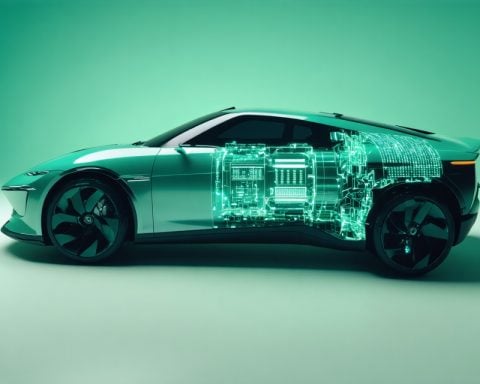- Nvidia is set to announce its fiscal fourth-quarter results amid market speculation and competitive pressures from China’s DeepSeek.
- DeepSeek claims to offer more efficient and cost-effective AI models, shaking Nvidia’s dominance, although Nvidia’s stock has begun to recover.
- CEO Jensen Huang’s address may redefine AI scalability and emphasize the necessity of Nvidia’s computational power.
- Nvidia expects impressive earnings, with forecasts around $42 billion for the upcoming fiscal quarter.
- The Blackwell chip platform, despite production challenges, remains crucial to Nvidia’s strategy.
- Huang is anticipated to counter DeepSeek’s impact and reassure investors of Nvidia’s ongoing importance in AI innovation.
- Nvidia’s situation illustrates how tech progress can be both challenging and a magnet for future innovation.
As Nvidia positions to reveal its fiscal fourth-quarter results, the tech world holds its breath. A storm of speculation churns around the powerhouse of AI chips, not least because of the disruption caused by China’s rising startup, DeepSeek. This new player seemed to shake Nvidia to its core, suggesting it had crafted AI models far more efficient and cost-effective than those requiring Nvidia’s robust chip arsenal. Yet, the market’s initial panic, which saw Nvidia’s stock plummet, has ebbed. Investors, though cautious, remain hopeful as shares recover.
Far more than just another quarterly earnings announcement, CEO Jensen Huang’s address could redefine the narrative on AI’s scalability and mindshare. Nvidia stands on the precipice, facing criticisms but also poised for applause should it deftly navigate these stormy tech waters. Expected earnings hint at impressive growth, with forecasts swelling to a stunning $42 billion in the coming fiscal quarter. Market analysts anticipate Huang will fiercely argue that AI’s growth is tethered not just to efficiency but also to the need for colossal computational muscle.
Adding complexity is Huang’s latest muse, the Blackwell chip platform, facing its production snafus but still critical to Nvidia’s pulse. The anticipation is electric as Wall Street eyes Huang, dubbed an AI oracle by tech insiders, for insight into the looming impact of DeepSeek and for reassurances on Nvidia’s forward momentum.
As Nvidia juggles these pressures, it hints at a broader lesson: Tech progress may stir unease, yet it powerfully attracts the next wave of innovation. Amidst technological revolution, Huang’s vision could persuade investors that Nvidia’s chips remain crucial in a world hungry for more AI-driven solutions.
Will Nvidia’s Bold Moves Secure Its Dominance in the AI Chip Market?
Understanding Nvidia’s Position in the AI Industry
Nvidia has long been a dominant force in the AI chip market, primarily due to its pioneering work with GPUs (Graphics Processing Units). As Nvidia prepares to reveal its fiscal fourth-quarter results, there are several factors and challenges at play that could drastically influence its market position.
Trending Topics in AI Chip Market
Real-World Use Cases
Nvidia’s GPUs are crucial for powering a range of AI applications:
– Autonomous Vehicles: Toyota, Tesla, and Mercedes-Benz utilize Nvidia’s technology for developing AI-powered self-driving systems.
– Healthcare: Nvidia’s GPUs are used in medical imaging diagnostics and drug discovery through AI models that require robust computational power.
– Gaming and Entertainment: The company’s GPUs enable realistic graphics and AI-enhanced features in video games.
– Cloud Computing: Major cloud providers like Amazon Web Services and Google Cloud rely on Nvidia’s technology for AI processing.
Market Forecasts & Industry Trends
– The market for AI accelerators, including GPUs, is expected to grow significantly. MarketsandMarkets forecast the AI chips market to reach $91.18 billion by 2025, growing at a CAGR of 40.1%.
– Nvidia’s expected revenue forecast of $42 billion for the next quarter suggests anticipated continued strength, despite emerging competitors like DeepSeek challenging its position.
Reviews & Comparisons
– Nvidia’s Blackwell chip platform, despite some production challenges, is touted as a groundbreaking advancement in computational power that could outperform many existing solutions, evidenced by industry excitement and anticipation.
– Competitive comparisons often highlight Nvidia’s superior software ecosystem, including its CUDA platform, which offers developers flexibility that is not yet fully matched by competitors.
The DeepSeek Disruption: A Controversy in the Making
The emergence of China’s DeepSeek has stirred the industry, suggesting the potential to deliver AI solutions more cost-effectively. The following issues are crucial:
– Technological Efficiency: DeepSeek claims its AI models require less computational power, a challenge to Nvidia’s high-performance narrative.
– Market Reaction: Initial panic around Nvidia’s stock showed investor sensitivity to such competitive threats, although the quick rebound suggests confidence in Nvidia’s long-term strategy.
Features, Specs & Pricing of Nvidia’s Offerings
– Blackwell Chip: Known for robust AI capabilities with high transistor density increases, crucial for deep learning applications.
– Competitive Pricing: Nvidia typically positions its GPUs at a premium, justified by proprietary technology and performance metrics, yet competitive threats could drive strategic price adjustments.
Security & Sustainability
– Nvidia is actively working on developing sustainable computing technologies to reduce carbon footprints associated with high-performance computing.
– Security features in Nvidia’s platforms include robust encryption and secure execution environments, which are crucial for enterprise AI applications.
Insights & Predictions
– AI Scalability: Nvidia is poised to lead AI scalability discussions, focusing on a blend of efficiency and necessary computational muscle.
– Emerging Markets: Expect Nvidia to explore strategic partnerships or acquisitions, especially in emerging AI markets to maintain marketplace relevance.
Pros & Cons Overview
Pros:
– Market leadership and brand recognition.
– Extensive ecosystem of software and developer tools.
– Robust R&D investment yielding cutting-edge technology.
Cons:
– Premium pricing could deter cost-sensitive customers.
– Production issues with new platforms like Blackwell could delay market entry.
– Increasing competition from companies with novel, less expensive AI models.
Actionable Recommendations
– Investors: Consider Nvidia’s long-term potential in diversifying AI applications despite short-term market volatility.
– Developers: Leverage Nvidia’s software tools to optimize AI solutions for gaming, automotive, and cloud platforms.
– Consumers and Enterprises: Stay informed on Nvidia’s product launches and competitive developments to make technologically advanced, yet sustainable choices.
For more on Nvidia’s latest developments, visit the official Nvidia website. Stay tuned to see how Nvidia navigates the growing AI landscape amid these challenges.

















